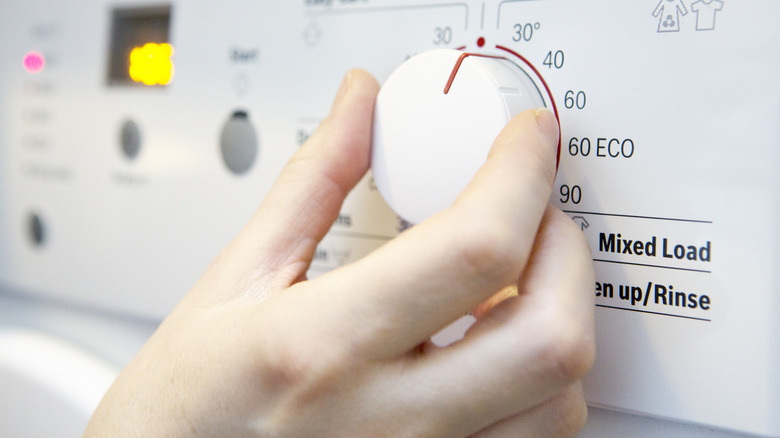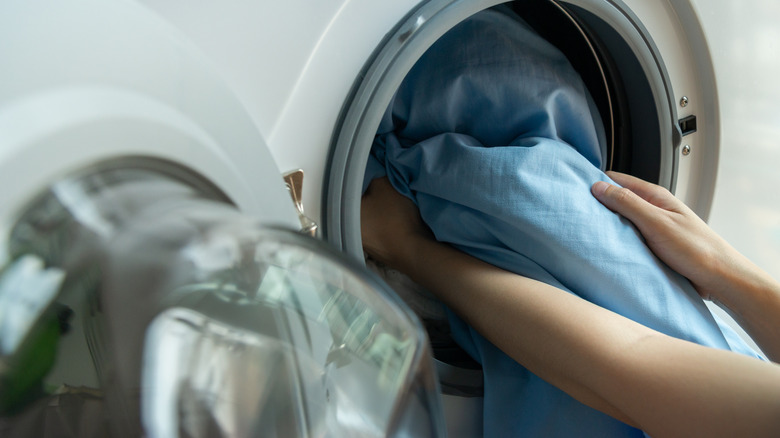Should You Use Hot Or Cold Water To Wash Your Bedding?
We spend a third of our lives in bed, and hopefully, those hours are in clean sheets. Pillowcases, bedsheets, and duvets get the pleasure of housing all the skin cells, dust, and bodily fluids that accumulate when we sleep. For the health of you and your home, it's critical to launder your bedding regularly and at the right temperature setting. While hot water can eliminate dust mites, it can also damage the textile fibers. Cold water is better for the environment, but it might not thoroughly sanitize. Turns out, both cycles are necessary when laundering your bedding — cold water for routine washes and hot water for deep cleans.
How often you need to clean your sheets depends on your lifestyle. Ideally, your bed sheets should be washed every one to two weeks, while blankets and duvets are fine with a monthly cleanse. However, if you have pets, sweat heavily, or eat in bed, more frequent washings are best. With such constant laundering, using the proper water temperature ensures your sheets last as long as possible but are also as fresh as can be.
Cold water is best for routine washing
Using cold water is best for your standard load of bedsheets and comforters. Provided the water in your pipes isn't icy, room-temperature washes can work just as well as hot water cycles to launder your bedding, and you get the bonus of reduced wear on your linens. The low temperatures are gentler on fabrics and can keep your sheets vibrant for longer, as there is less risk of the colors running or the fibers shrinking. Cold water can also reduce wrinkles, so you can skip the ironing and emulate the look of a five-star hotel in your bedroom with less effort.
Plus, setting the washing machine to the cold cycle is also an eco-friendly change you can make to your laundry routine. Around 70 to 90% of the electricity used in washing goes toward heating the water, so selecting the cold program can save energy and reduce utility costs. However, every so often, the disinfecting power of hot water is necessary.
Use hot water for deep cleaning your bedding
It's safe to turn up the temperature when it's time to deep clean your bedding. But, before spinning the hot water cycle, check the care tags on your linens. Some delicate fabrics, like silk, can't handle high temperatures and are best washed only using cold water. If there aren't any care tags, moderately warm (under 86 degrees Fahrenheit) or cold water is the safest bet, especially for finer fabrics.
Providing your linens can handle the heat, hot water is great for occasionally washing your bedding because it can kill dust mites, bacteria, and viruses that lock into the fabric. Removing natural oils, dirt, grime, and certain stains is also easier at higher temperatures. That said, hot water can be bad news for some stains, such as blood, urine, tea, milk, red wine, and coffee, essentially "cooking" them into the fabric. It is best to handle protein-based marks with cold water and spot-treat them first before throwing the fabrics into a hot washer cycle.
While it's tempting to sanitize all loads using hot water, you'll want to reserve high-temperature cycles for deep cleans, leveraging them roughly one in every five washes. Hot water cycles typically reach 130 degrees Fahrenheit or warmer, and those temperatures can cause bedding to shrink, fade, and break down over time. Using the wrong wash setting is a major mistake you can avoid when washing your sheets. So, stick primarily with cold water, but treat your bedding to a hot bath every once in a while.


